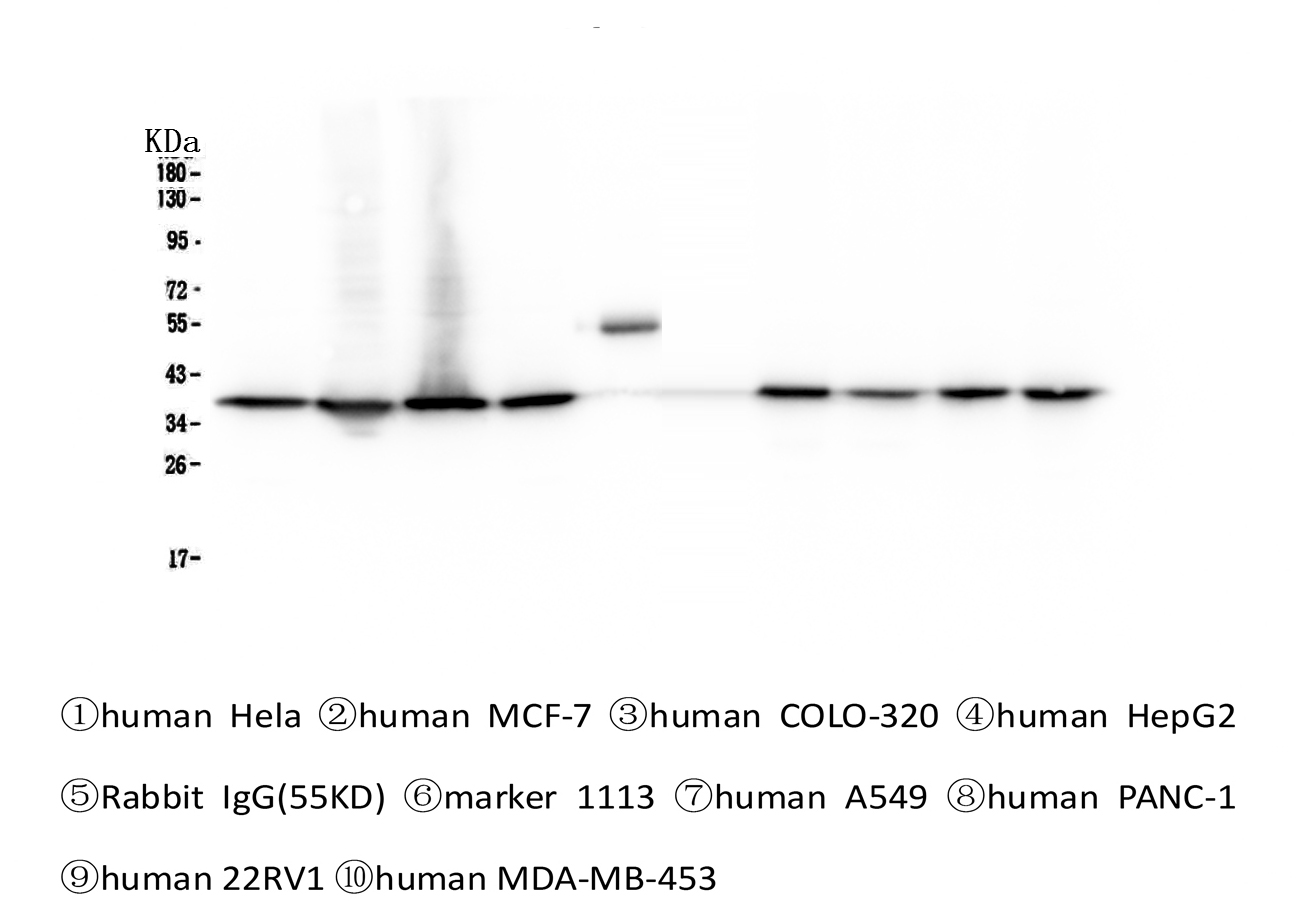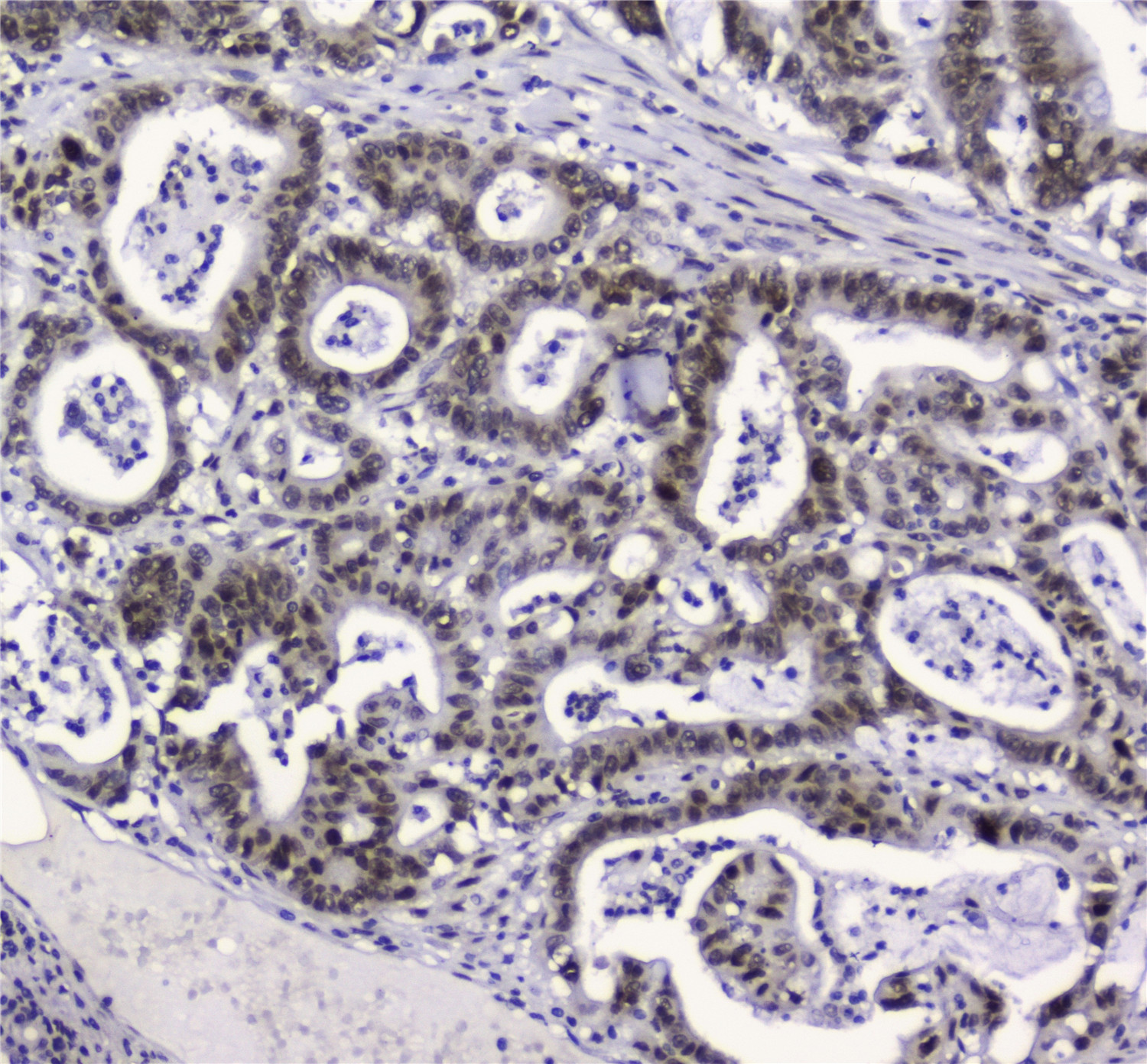| Western blot (WB): | 1:500-2000 |
| Immunohistochemistry (IHC): | 1:50-400 |
| Flow Cytometry (Fixed): | 1:50-200 |
| (Boiling the paraffin sections in 10mM citrate buffer,pH6.0,or PH8.0 EDTA repair liquid for 20 mins is required for the staining of formalin/paraffin sections.) Optimal working dilutions must be determined by end user. | |

Western blot analysis of anti-APEX1 antibody (M00627). The sample well of each lane was loaded with 30 ug of sample under reducing conditions.
Lane 1: human Hela whole cell lysates,
Lane 2: human MCF-7 whole cell lysates,
Lane 3: human COLO-320 whole cell lysates,
Lane 4: human HepG2 whole cell lysates,
Lane 5: Rabbit IgG,
Lane 6: Marker 1113,
Lane 7: human A549 whole cell lysates,
Lane 8: human PANC-1 whole cell lysates,
Lane 9: human 22RV1 whole cell lysates,
Lane 10: human MDA-MB-453 whole cell lysates.
After electrophoresis, proteins were transferred to a membrane. Then the membrane was incubated with mouse anti-APEX1 antigen affinity purified monoclonal antibody (M00627) at a dilution of 1:1000 and probed with a goat anti-mouse IgG-HRP secondary antibody (Catalog # BA1050). The signal is developed using ECL Plus Western Blotting Substrate (Catalog # AR1197). A specific band was detected for APEX1 at approximately 36 kDa. The expected band size for APEX1 is at 36 kDa.

IHC analysis of APEX1 using anti-APEX1 antibody (M00627).
APEX1 was detected in a paraffin-embedded section of human intestinal cancer tissue. The tissue section was incubated with mouse anti-APEX1 Antibody (M00627) at a dilution of 1:200 and developed using HRP Conjugated mouse IgG Super Vision Assay Kit (Catalog # SV0001) with DAB (Catalog # AR1027) as the chromogen.

Flow Cytometry analysis of SiHa cells using anti-APEX1 antibody (M00627).
Overlay histogram showing SiHa cells stained with M00627 (Blue line). To facilitate intracellular staining, cells were fixed with 4% paraformaldehyde and permeabilized with permeabilization buffer. The cells were blocked with 10% normal goat serum. And then incubated with mouse anti-APEX1 Antibody (M00627) at 1:100 dilution for 30 min at 20°C. DyLight®488 conjugated goat anti-mouse IgG (BA1126) was used as secondary antibody at 1:100 dilution for 30 minutes at 20°C. Isotype control antibody (Green line) was mouse IgG at 1:100 dilution used under the same conditions. Unlabelled sample without incubation with primary antibody and secondary antibody (Red line) was used as a blank control.

Western blot analysis of anti-APEX1 antibody (M00627). The sample well of each lane was loaded with 30 ug of sample under reducing conditions.
Lane 1: human Hela whole cell lysates,
Lane 2: human MCF-7 whole cell lysates,
Lane 3: human COLO-320 whole cell lysates,
Lane 4: human HepG2 whole cell lysates,
Lane 5: Rabbit IgG,
Lane 6: Marker 1113,
Lane 7: human A549 whole cell lysates,
Lane 8: human PANC-1 whole cell lysates,
Lane 9: human 22RV1 whole cell lysates,
Lane 10: human MDA-MB-453 whole cell lysates.
After electrophoresis, proteins were transferred to a membrane. Then the membrane was incubated with mouse anti-APEX1 antigen affinity purified monoclonal antibody (M00627) at a dilution of 1:1000 and probed with a goat anti-mouse IgG-HRP secondary antibody (Catalog # BA1050). The signal is developed using ECL Plus Western Blotting Substrate (Catalog # AR1197). A specific band was detected for APEX1 at approximately 36 kDa. The expected band size for APEX1 is at 36 kDa.

IHC analysis of APEX1 using anti-APEX1 antibody (M00627).
APEX1 was detected in a paraffin-embedded section of human intestinal cancer tissue. The tissue section was incubated with mouse anti-APEX1 Antibody (M00627) at a dilution of 1:200 and developed using HRP Conjugated mouse IgG Super Vision Assay Kit (Catalog # SV0001) with DAB (Catalog # AR1027) as the chromogen.

Flow Cytometry analysis of SiHa cells using anti-APEX1 antibody (M00627).
Overlay histogram showing SiHa cells stained with M00627 (Blue line). To facilitate intracellular staining, cells were fixed with 4% paraformaldehyde and permeabilized with permeabilization buffer. The cells were blocked with 10% normal goat serum. And then incubated with mouse anti-APEX1 Antibody (M00627) at 1:100 dilution for 30 min at 20°C. DyLight®488 conjugated goat anti-mouse IgG (BA1126) was used as secondary antibody at 1:100 dilution for 30 minutes at 20°C. Isotype control antibody (Green line) was mouse IgG at 1:100 dilution used under the same conditions. Unlabelled sample without incubation with primary antibody and secondary antibody (Red line) was used as a blank control.


